Introduction
- Nutrition refers to the process by which living organisms obtain and assimilate (utilize) nutrients. It is one of the fundamental characteristics of living things.
- The nutrients obtained are useful to the living organisms in many ways:
- The nutrients are required for growth and development of the living organisms.
- The nutrients are required for energy provision as they are broken down to release energy.
- They nutrients are also required for repair of worn out tissues
- Nutrients are required for synthesis of very vital macromolecules in the body such as hormones and enzymes.
Modes of nutrition
There are two main nutrition modes:
- Autotrophism: mode of nutrition through which living organisms manufacture their own food from simple inorganic substances in the environment such as carbon (IV) oxide, water and mineral ions. Organisms that make their own food through this mode are autotrophs.
- Heterotrophism: mode of nutrition in which living organisms depend on already manufactured food materials from other living organisms. Heterotrophs are the organisms that feed on already manufactured food materials.
AUTOTROPHISM
- In this mode of nutrition, organisms manufacture their own food from readily available materials in the environment. These organisms use energy to combine carbon (IV) oxide, water and mineral salts in complex reactions to manufacture food substances. Depending on the source of energy used to manufacture the food, there are two types of autotrophism:
Chemosynthesis
- This is the process whereby some organisms utilize energy derived from chemical reactions in their bodies to manufacture food from simple substances in the environment.
- This nutrition mode is common in non green plants and some bacteria which lack the sun trapping chlorophyll molecule.
Photosynthesis
- This is the process by which organisms make their own food from simple substances in the environment such as carbon (IV) oxide and water using sunlight energy.
- Such organisms often have chlorophyll which traps the required sunlight energy.
- This mode of nutrition is common in members of the kingdom Plantae. Some protoctists and bacteria are also photosynthetic.
Importance of Photosytnthesis
- Photosynthesis helps in regulation of carbon (IV) oxide and oxygen gases in the environment.
- Photosynthesis enables autotrophs make their own food, thus, meet their nutritional requirements.
- Photosynthesis converts sunlight energy into a form (chemical energy) that can be utilized by other organisms that are unable to manufacture their own food.
- Photosynthesis largely occurs in the leaf. To understand the process of photosynthesis, it is important to understand the leaf structure.
External leaf structure
- Externally, the leaf has a petiole through which it attaches to the leaf branch or stem, lamina- the broad flat surface, margin- the outline and the leaf apex.
- The leaf margin can be smooth, dentate, serrated or entire.
- The size of a leaf depends on its environment. Plants in arid areas have small sized leaves with some leaves reduced to needle like shape. This helps reduce the rate of water loss in such plants. However, the plants in areas of water abundance have broad leaves to enable them lose the excess water.

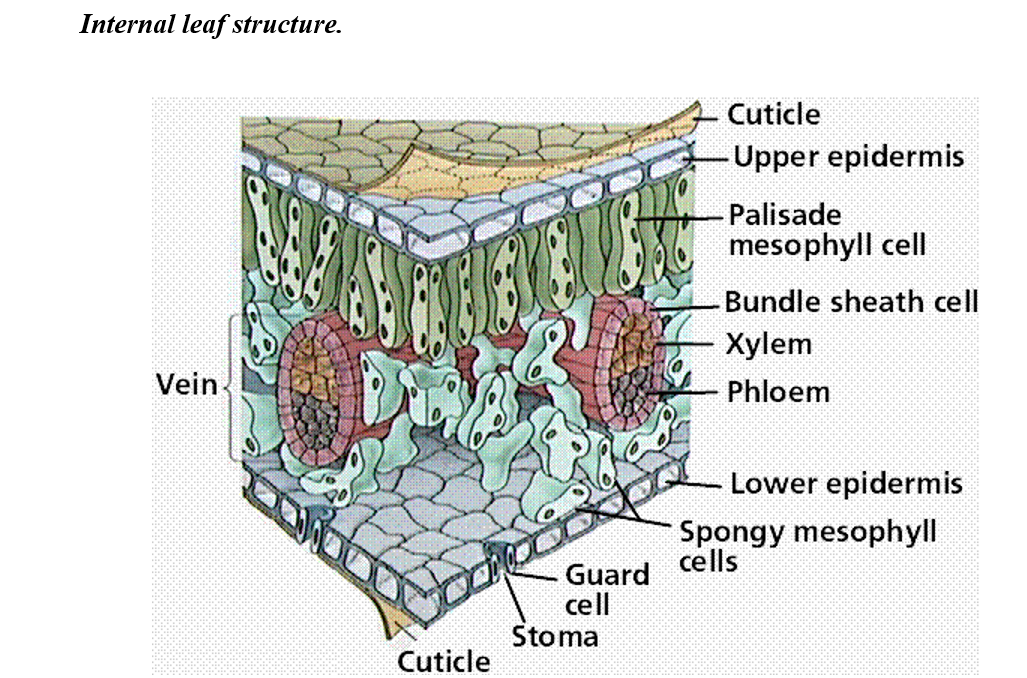
Cuticle
- This is the outermost layer of the leaf.
- It is a thin non-cellular, waxy, transparent and waterproof layers that coats the upper and lower leaf surfaces.
Functions of the cuticle
- Being waterproof, it minimizes water loss from the leaf cells to the environment through transpiration and evaporation.
- It protects the inner leaf tissues from mechanical damage.
- It prevents entry of pathogenic microorganisms into the leaf.
Epidermis
- This is the outermost one cell thick layer covering upper and lower leaf surfaces. Its cells are flattened and lack chloroplasts.
Functions of the epidermis:
- It protects the leaf from mechanical damage.
- It also protects the leaf from entry of disease-causing microorganisms.
- It secretes the cuticle.
- There are many small pores on the epidermis known as stomata (singular-stoma) through which exchange of materials occur. The opening and closing of the stomata is controlled by the guard cells. Each stoma is controlled by two guard cells.
- The guard cells have chloroplasts and are bean shaped. They have thicker inner cell wall and thinner outer cell wall.
Adaptations of the guard cells
- They have differentially thicker walls to enable them bulge as they draw water through osmosis from the neighboring cells making them to open the stomata.
- They contain chloroplasts that manufacture sugars which increase osmotic pressure of the guard cells. As they draw water through osmosis, they bulge making the stomata to open.
Palisade mesophyll
- This is the chief photosynthetic tissue in plants. Its cells are regular in shape.
- Its cells contain numerous chloroplasts for photosynthesis.
- Their close packing and location just below the epidermis enables them to trap maximum sunlight for photosynthesis.
- Location of palisade layer on the upper surface explains why upper leaf surfaces are greener than the lower surfaces.
Spongy mesophyll layer
- This layer contains loosely arranged irregular cells. This leaves large airspaces between the cells which permits free circulation of gases carbon (IV) oxide and oxygen into the photosynthetic cells. Spongy mesophyll cells contain fewer chloroplasts compared to palisade cells.
Vascular bundle/tissue
- This is found in the midrib and leaf veins. Vascular bundle is made of phloem and xylem tissues. Xylem tissues conduct water and some dissolved mineral salts from the roots to other plant parts while phloem translocates manufactured food materials from photosynthetic areas to other plant parts.
Chloroplast
- This is the organelle in which photosynthesis takes place. It is an oval shaped double membrane bound organelle.
- Internally, it is made up of membranes called lamellae suspended in a fluid filled matrix called stroma.
- Lamellae forms stacks at intervals called grana (singular-granum). Chlorophyll molecules are contained in the grana.
- Within the stroma, fat droplets, lipid droplets and starch grains are found.
- The strona contains enzymes and forms the site where light independent reactions take place.
Adaptations of the leaf to photosynthesis
- The leaf has a flat snd broad lamina to increase surface area for trapping sunlight energy and for gaseous exchange.
- The leaf has numerous stomata through which photosynthetic gases diffuse.
- The leaf is thinto reduce the distance through which carbon (IV) oxide has to diffuse to the photosynthetic cells.
- The palisade mesophyll cells contain numerous chloroplasts which contain chlorophyll molecules which trap sunlight energy for photosynthesis.
- The photosynthetic mesophyll is located towards the upper surface for maximum absorption of sunlight energy.
- The leaf has an extensive network of veins composed of xylem which conducts water to the photosynthetic cells and phloem to translocate manufactured food materials to other plant parts.
- The epidermis and cuticle are transparent to allow light to penetrate to the photosynthetc cells.
Raw materials for photosynthesis
- Water
- Carbon (IV) oxide
Conditions for photosynthesis
- Light energy
- Chlorophyll
PHOTOSYNTHESIS PROCESS
- Photosynthesis is a complex process that involves a series of reactions. It can be summarized into two main reactions.
Light reaction/Light stage
- This is the first stage of photosynthesis. It occurs in the presence of light. Without light it cannot take place.
- Light stage occurs in the grana of the chloroplasts.
- During light stage, two fundamental processes occur:
Photolysis of water
- This refers to the splitting of water molecules using sunlight energy to give hydrogen ions and oxygen gas.
- This is aided by the fact that the grana contain chlorophyll molecules that trap sunlight energy for photolysis.
- The oxygen gas produced can either be released into the atmosphere or be utilized by the plant for respiration.
Water = Hydrogen atoms + Oxygen gas
- Formation of adenosine triphosphate (ATP)
- Some of the sun light energy is used to combine Adenosine Diphospate molecule in the plant tissues with a phosphate molecule to form Adenosine Triphosphate (ATP). ATP is an energy rich molecule that stores energy for use in the dark stage when sunlight energy could be unavailable.
ADP + P à ATP
- The hydrogen ions and ATP formed during light stage are later used in dark stage.
- Dark reaction/Dark stage
- These reactions are light independent. The energy that propels these reactions are derived from the ATP formed during light stage.
- Also known as carbon (IV) oxide fixation, dark stage involves combination of carbon (IV) oxide molecule with hydrogen ions to form a simple carbohydrate and a water molecule.
- Dark reactions take place in the stroma.
CO2 + 4H+ = (CH2O)n + H2O
- Other food materials are then synthesized from the simple sugars through complex synthesis reactions.
- The simple sugar formed in dark stage is quickly converted to starch which is osmotically inactive. When a lot of simple sugars accumulate in the chloroplasts, osmotic pressure of the guard cells would increase causing the guard cells to draw a lot of water through osmosis. This makes the guard cells to bulge and open the stomata. This can result into excessive water loss.
- To prevent, this, the simple sugars are quickly converted to starch. To test whether photosynthesis has taken place in a leaf, therefore, a test for presence of starch and not simple sugars is carried out.
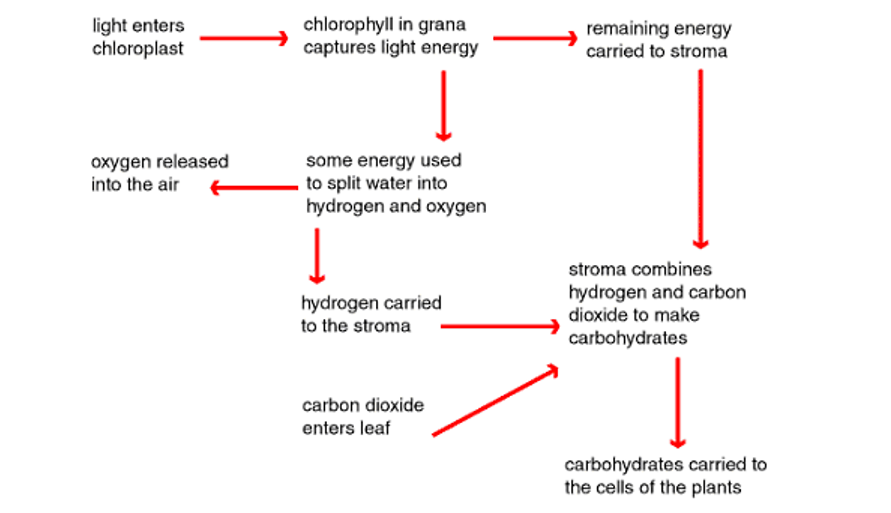
Testing for starch in a leaf
Requirements
- Iodine solution
- Methylated spirit/alcohol
- Boiling tube
- Droppers
- Water
- White tile
- Fresh leaf
- Means of heating
- Timer
Procedure
- Detach a leaf that has been exposed to light for about six hours. This duration ensures that the leaf has photosynthesized.
- Put the leaf in boiling water for 10 minutes. This kills the protoplasm, denatures the enzymes and stops any chemical reactions in the leaf.
- Remove the leaf and put it in a boiling tube containing methylated spirit or alcohol and boil in a water bath. Methylated spirit is highly flammable hence should be boiled indirectly. Boiling with methylated spirit or alcohol decolourises the leaf (removes the chlorophyll). This ensures that the leaf becomes white so that colour changes can be observed easily when iodine is added.
- Remove the leaf and wash off in hot water to remove methylated spirit and to soften the leaf.
- Spread the leaf on a white tile and add drops of iodine solution onto the leaf and observe.
Observations
- If there is formation of blue black patches on the leaf then starch is present
- If the yellow/brown colour of iodine persists on the leaf then starch is absent in the leaf.
Factors affecting the rate of photosynthesis
- Carbon (IV) oxide concentration
- While the concentration of carbon (IV) oxide in the atmosphere is fairly constant at 0.03%, an increase in carbon (IV) oxide concentration translates into an increase in the rate of photosynthesis upto a certain point when the rate of photosynthesis becomes constant. At this point, other factors such as light intensity, water and temperature become limiting factors.
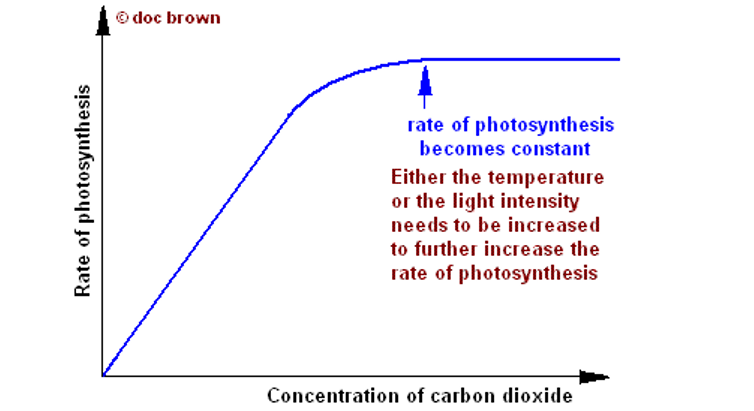
2. Light intensity
- The rate at of photosynthesis increases with an increase in light intensity up to a certain level. Beyond the optimum light intensity the rate of photosynthesis becomes constant. To this effect, plants photosynthesize faster on bright and sunny days than on dull cloudy days.
- Light quality/wavelength also affects the rate of photosynthesis. Most plants require red and blue wavelengths of light for photosynthesis. Light duration also affects photosynthesis rate.
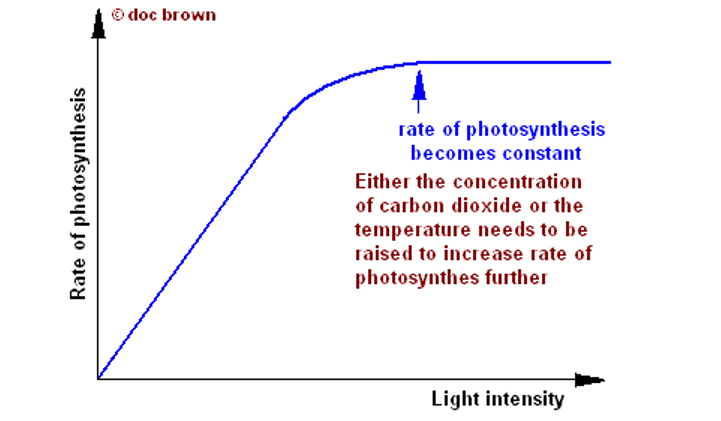
3. Temperature
- Photosynthesis is an enzyme controlled process. At very low temperatures the rate of photosynthesis is slow because the enzymes are inactive. As temperature increases, the rate of photosynthesis increases because the enzymes become more active. Rate of photosynthesis is optimum at (35-40) °C. Beyond 40°C the rate of photosynthesis decreases and eventually stops since the enzymes become denatured.
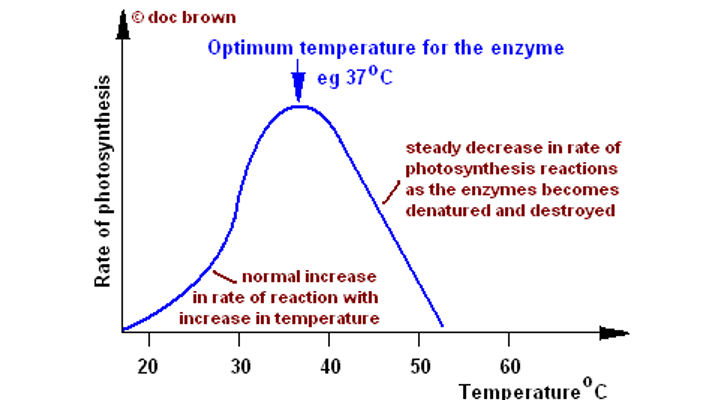
Water
- Water is a raw material for photosynthesis. At extreme level of water shortage, rate of photosynthesis will be severely affected.
Experiment to investigate the gas produced during photosynthesis
Requirements
- Water plant e.g. elodea, spirogyra, Nymphea (water lily), glass funnels, beakers, small wooden blocks, test tubes, wooden splints and sodium hydrogen carbonate.
Procedure
- Set up the apparatus as shown in the figure below
- Place the set up in the sunlight to allow photosynthesis to take place.
- Leave the set up in the sun until sufficient gas has collected in the test tube.
- Test the gas collected with a glowing splint.
- Record your observations.
Note:
- In this experiment, sodium hydrogen carbonate is added to the water to boost the amount of carbon (IV) oxide in the water since water has a low concentration of carbon (IV) oxide.
- A water plant is also selected because water plants are adapted to photosynthesis under the low light intensity in water where terrestrial plants cannot easily photosynthesize.
- This experiment can also be used to investigate the factors affecting the rate of photosynthesis:
Carbon (IV) oxide concentration: Carry out the experiment using different amounts of dissolved sodium hydrogen carbonate e.g 5g, 10g, 15g, 20g and examine the rate at which the gas collects.
- Light intensity: An artificial light source can be used. Illuminate the plant and vary the distance between the set up and the light source while recording the time it takes for the gas jar to fill or counting the number of bubbles peer unit time.
- Temperature: carry out the experiment at varying temperatures and record the rate at which the gas collects.
Experiments on factors necessary for photosynthesis
Light
Requirements
- Methylated spirit, iodine solution, water, white tile, droppers, beaker, source of heat, boiling tube, light proof material e.g. aluminium foil, potted plant and clips.
Procedure
- Cover two or more leaves of a potted plant with a light proof material.
- Place the plant in a dark place for 48 hours (keeping the plant in the dark for 48 hours is to ensure that all the starch in it is used up. This makes the leaves ideal for investigating whether starch would form in the experimental period. This is called destarching).
- Transfer the potted plant to light for 5 hours.
- Detach and uncover the leaves and immediately test for starch in one of the covered leaves and one that was not covered.
Carbon (IV) oxide
Requirements
- Sodium hydroxide pellets, flask, jelly
Procedure
- Destarch the plant for 48 hours
- Place a few pellets of sodium hydroxide in the flask
- Bore a hole in the cork of the same size as the petiole of the leaf being used
- Cut the cork lengthwise.
Chlorophyll
- For this experiment, a variegated leaf is required. This is a leaf in which some patches lack chlorophyll.
- These patches could be yellow. They lack chlorophyll hence photosynthesis does not take place in them.
Procedure
- Detarch or remove variegated leaf that has been exposed to light for at least three hours.
- Draw a large diagram of the leaf to show the distribution of the chlorophyll
- Test the leaf for starch and record observations.
CHEMICALS OF LIFE
- These are chemical compounds that constitute the living organisms.
- Biochemistry is the branch of biology that deals with the study of the chemicals of life and their reactions.
- Chemicals of life include carbohydrates, proteins and lipids.
Carbohydrates
- Are compounds of carbon, hydrogen and oxygen in the ratio of 1:2:1.
- They have a general formula (CH2O)n where n represents the number of carbon atoms.
- Carbohydrates are grouped into three categories:
Monosaccharides
- These are the simplest carbohydrates.
- They include glucose, fructose, galactose.
- Their general formula is C6H12O6.
Properties of Monosaccharides
- They are sweet tasting
- They readily dissolve in water
- They are crystallisable
- They are reducing sugars; monosaccharides reduce blue copper (II) sulphate in Benedict’s solution to red brown copper (I) oxide when heated.
Note:
- Most fruits are sweet tasting because they contain a lot of monosaccharides.
- Monosaccharide units can be combined to form complex carbohydrate molecules through a process known as condensation. Water molecules are produced in the process.
Functions
- They are the chief respiratory substrate. They are broken down to release energy in the body.
- They are condensed to form complex important carbohydrates.
Disaccharides
- These are complex sugars formed by linking two monosaccharide units through condensation.
- They have a general formula C12H22O11. The bond that holds two monosaccharide units is called glycosidic bond.
- Examples of disaccharides include:
- Maltose-common in germinating seeds
- Sucrose-fruits and sugar cane. Sucrose is the form in which carbohydrates are transported in plants
- Lactose- found in milk
Properties of Disaccharides
- They are sweet tasting
- They are crystallizable
- They are water soluble
- While they are non reducing sugars, some such as maltose is sugar reducing and is known as a complex reducing sugar.
- They can be broken down into their constituent monosaccharide units through hydrolysis. Hydrolysis is the process through which complex molecules are broken down in the presence of water molecules.
- In living systems, hydrolysis is carried out by enzymes. However, in the laboratory, hydrolysis can be carried out by boiling the disaccharide in dilute aid such as hydrochloric acid.
Functions
- They are hydrolyzed into monosaccharides and respired on to yield energy
- They are the form in which carbohydrates are transported in plants due to their soluble and inert nature.
Polysaccharides
- These are formed through linking of numerous monosacchride units through condensation.
- Their general formula is (C6H10O5)n where n is a very large number.
Properties of polysaccharides
- They are non sweet
- They do not dissolve in water
- They are non crystalline
- They are non-reducing sugars
Examples of polysaccharides
- Starch– Made by linking numerous glucose molecules. It is a form in which carbohydrates are stored in plants.
- Glycogen– Is a storage carbohydrate in liver and muscles of animals. It is broken down to glucose in animals when blood glucose falls.
- Cellulose– This is a structural polysaccharide in plants. It is a component of the cell wall
- Chitin– A structural carbohydrate found in cell wall of fungi and arthropod exoskeletons
Functions of polysaccharides
- They are storage carbohydrates; their insolubility and inertness makes them ideal for storing carbohydrates.
- They are structural carbohydrates e.g. cellulose forms the plant cell walls
- They can be hydrolyzed into monosacharides and be broken down to release energy
Lipids
- These are compounds of carbon, hydrogen and oxygen. However, they contain lesser oxygen but higher hydrogen compared to carbohydrates.
- Building units for lipids are fatty acids and glycerol. To synthesize a molecule of lipid, three fatty acids and a glycerol molecule are linked through a condensation reaction.
- There is one type of glycerol but numerous fatty acids
- There are different types of fatty acids. The property of a lipid therefore depends on the type of fatty acids that link up with the glycerol.
- There are complex lipids such as phospholipids, steroids, waxes and cholesterol. These also form through condensation.
Properties of lipids
- Fats easily change to oil when heated while oils easily solidify when cooled.
- They are insoluble in water but readily dissolve in organic solvents such as chloroform to form emulsions
- They are inert hence can be stored in tissues of organisms.
Functions
- They are a source of energy when oxidized. They yield more energy compared to carbohydrates when oxidized per unit weight. However, they are less preferred as source of energy because they require a lot of oxygen to oxidize. In addition, they are insoluble hence not easy to transport to respiratory sites.
- They are a source of metabolic water. When oxidized, they yield a lot of metabolic water. This explains why some desert animals such as camels store large quantities of fat in their bodies.
- Lipids offer protection to internal organs as they are deposited around them to act as shock absorbers.
- Lipids provide heat insulation when stored underneath the skin as they are poor conductors of heat hence do not conduct heat away from the body. Organisms in cold areas tend to be short and plump as they have fatter fat adipose.
- Lipids form structural compounds for instance phospholipids in cell membrane.
- Complex lipids such as waxes in leaves help minimize water loss through transpiration.
- Some lipids mediate communication between cells
Proteins
- These are compounds of carbon, hydrogen and oxygen. In addition, they also contain nitrogen and sometimes phosphorous or sulphur or both.
- Some proteins molecules contain other elements. In particular, haemoglobin contains iron.
- Proteins are made up of amino acids. There are about twenty known amino acids. Amino acids are of two kinds:
- Essential– These are those amino acids that cannot be synthesized by the body systems hence have to be supplied in the diet.
- Non essential– These are amino acids that can be synthesized by the body mechanisms hence do not need to be supplied in the diet.
- An amino acid has an amino group, carboxyl group, hydrogen atom and an alkyl, R group. Amino acids differ from each other by the alkyl group.
- Proteins are of two kinds:
- First class proteins- Contain all essential amino acids
- Second class proteins- Proteins lack one or more essential amino acids
Protein synthesis
- Two amino acids combine through a condensation process to form a dipeptide molecule. Several amino acids link up to form a polypeptide chain. Proteins are made up of long chain polypeptides.
- Properties of a protein depend on the type of amino acids present in its chain and the sequence in which the amino acids link up in the polypeptide chain.
Properties of Proteins
- They dissolve in water to form colloidal suspensions in which the particles remain suspended in water.
- They are denatured at temperatures beyond 40°C. Strong acids, bases, detergents and organic solvents also denature proteins.
- They are amphoteric- possess both basic and basic properties.
- This property enables them to combine with other non protein substances to form conjugated proteins such as:
- Mucus- Protein plus carbohydrate
- Haemoglobin- Protein plus iron
Functions of proteins
- They are structural compounds of the body. Cell membrane is protein in nature. Hair, nails and hooves are made up of protein keratin.
- Proteins are broken down to release energy during starvation when all carbohydrate and lipid reserves are depleted.
- Functional proteins play vital roles in metabolic regulation. Hormones are chemical messengers while enzymes regulate the speed of metabolic reactions.
- Proteins such as antibodies provide protection to the body against infections
- Some protein molecules are transport molecules. Haemoglobin molecule plays a crucial role in transportation of respiratory gases.
- Proteins play a vital role in blood clotting e.g. fibrinogen.
- Contractile proteins such as actin and myosin bring about movement.
ENZYMES
What are enzymes?
Are organic catalysts that are protein in nature and regulate the rate of metabolic reactions.
They speed up or slow down the rate of metabolic reactions but to not get used up in the process.
Types of enzymes
- Extracellular: Are produced within the cells but used outside the cells e.g. digestive enzymes.
- Intracellular: Are enzymes produced and used within the cells e.g. respiratory enzymes.
Importance of Enzymes
- They speed up the rate of chemical reactions that would otherwise be too slow to support life.
- Some enzymes take part in synthesis/building of useful complex substances such as DNA.
- Digestive enzymes breakdown complex food substances into simple foods that can be utilized by the cells.
- Some metabolic enzymes such as catalase play a vital role in detoxification (making poisonous substances less harmful.
Enzyme nomenclature
- Two systems of naming enzymes have been adopted.
1. Trivial naming
- This is where an enzyme is named by the scientist who discovered it.
- In trivial naming all enzyme names end in prefix –in.
- Examples
- Pepsin (Theodor Schwann, German physiologist -1836).
- Ptyalin (Anselme Payen, a French chemist- 1833).
2. Use of suffix –ase
Enzymes are assigned names by adding suffix –ase to the food substrate acted by the enzyme or by adding the suffix to the reaction being catalyzed by the enzyme.
Substrates
Amylose (starch)…………..amylase.
Lipids……………………….lipase.
Protein……………………. .protease.
Carbohydrate……………….carbohydrase.
Lactose………………………lactase
Processes/Reactions
Hydrolysis………………….hydrolase
Reduction…………………..reductase
Oxidation……………………oxidase
Mechanism of action of Enzymes
- Enzymes are not used up during metabolic reactions. They do have “active sites” through which the substrate molecules bind to the enzymes. The reaction is then catalyzed and the end products released. The enzyme is free to bind with another substrate molecule. The enzymes can be used again and again.
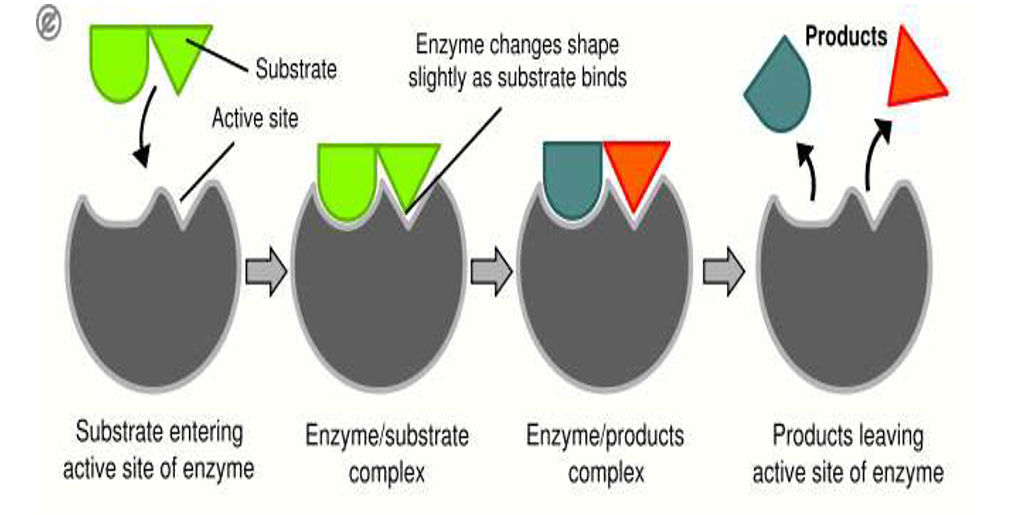
Properties of Enzymes
- They are protein in nature; hence affected by temperature and pH.
- They are substrate specific e.g. maltase cannot digest sucrose.
- They are efficient in small amounts since they are re-used in the reactions.
- They mostly take part in reversible reactions.
- They regulate the rate of metabolic activities but are not used up.
Factors affecting enzyme activity
- Substrate Concentration.
- Enzyme Concentration.
- Enzyme co-factors and co-enzymes; Fe, Mg, Zn, Cu ions.
- Enzyme inhibitors.
Temperature
- At low temperatures, kinetic energy of enzymes and molecules are low. There are few collisions leading to low enzyme activity.
- As temperature increases, the kinetic energy of the enzyme and substrate molecules increases leading to increased collisions hence increase in enzyme activity.
- Enzyme activity is optimum at (35 -40)°C.
- Beyond 40 °C the rate of enzyme activity decreases and eventually stops. This is because enzymes get denatured and their active sites get destroyed.
pH
- Enzymes work best under different pH conditions.
- Some enzymes work best under alkaline conditions e.g amylase. Some also work better under acidic conditions e.g. pepsin. However, most intracellular enzymes work better under neutral conditions.
- Altering the pH conditions would affect enzyme activity.
Enzyme Specificity
- A particular enzyme will only act on a particular substrate or will only catalyze a particular reaction.
- For instance, sucrase enzymes can only breakdown sucrose.
Substrate Concentration
- Assuming all other factors are constant, t low substrate concentration, the rate of enzyme activity is low.
- Increase in substrate concentration increases the rate of enzyme activity since more active sites of the enzymes will be occupied and there will also be an increase in enzyme-substrate collisions leading to increased reaction.
- The reaction increases up to a point at which it becomes constant. At this point, all active sites are utilized. The enzymes become the limiting factor of reaction. Increasing enzyme concentration would increase the rate of enzyme activity.
Enzyme Concentration
- An increase in enzyme concentration increases the rate of enzyme reaction up to a level beyond which the rate of reaction becomes constant.
- At low enzyme concentration, rate of enzyme activity is low because there are fewer sites and also fewer enzyme-substrate collisions that would lead to reactions.
- Increasing enzyme concentration increases rate of enzyme activity since there will be an increase in number of active sites and enzyme-substrate collisions.
- At optimum enzyme concentration, substrate concentration is the limiting factor. Increasing substrate concentration increases the rate of reaction.
Enzyme co-factors
- These are inorganic substances which activate enzymes.
- Without them, most enzymes would not function properly.
- Co- factors include mineral ions like iron, magnesium, copper, manganese, zinc as well as vitamins.
- They are used again and again since like enzymes, they do not get used up during the reactions.
Co-enzymes
- These are organic molecules that are required by some enzymes for their efficient functioning. Some enzymes will not function without them.
- Most co-enzymes are derivatives of vitamins.
- Examples
NAD- Nicotine Adenine Dinucleotide.
FAD- Flavine Adenine Dinucleotide.
NADP- Nicotine Adenine Dinucleotide Phosphate.
Enzyme inhibitors
- These are chemical substances which slow down or eventually stops enzyme activity.
- They are of two types:
- Competitive
- Non- competitive
Competitive inhibitors
- These are chemical substances which are structural analogs of the substrates i.e. they take up the shape of the substrates and compete for the active sites of the enzymes.
- They bind with the enzymes and do not disentangle easily (they stay in the enzyme active site for a long time) thereby slowing down the rate of enzyme activity.
- The reaction can be increased by increasing the substrate concentration.
Non competitive inhibitors
- These are inhibitors that do not resemble the substrate molecules but they combine with the enzyme at any site other the active site and alter the structure of the active site of the enzyme. The normal substrate, therefore, fails to bind to the active site leading to decreased rate of reaction.
- Note that these substances do not compete for the active sites of the enzymes.
- The enzymes are destroyed permanently hence the effect cannot be reversed.
Examples of non competitive inhibitors
Heavy metals (such as lead, mercury, silver), Cyanide, organophosphates such as malathion.
HETEROTROPHISM
- This is a mode of nutrition in which organisms take in already manufactured complex food substances such as carbohydrates, proteins and lipids.
- Heterotrophs are organisms that feed on already manufactured food substances.
- These substances are broken down in the bodies of the Heterotrophs into simple soluble food substances that can be absorbed and be utilized by the cells.
Modes of Heterotrophism
- There are four main heterotrophic modes on nutrition:
- Holozoic- Where organisms ingest, digest and assimilate solid complex food substances.
- Saprophytism – Where organisms feed on dead decaying matter causing decomposition.
- Parasitism- a feeding association in which one organism (parasite) feeds on or obtain nutrients on another organism, the host.
- Symbiosis/Mutualism- An association where two organisms live together and mutually benefit from each other.
Parasitism
- There are two main types of parasites:
- Endo parasites- Live inside the host
- Ecto-parasites- Found on the external surface of the host.
- The parasite benefits but the host does not. Some of the parasites cause diseases to the hosts and damage their tissues thereby weakening them.
Symbiosis
- In saprophytism, both organisms benefit:
- Symbiotic r/ships include
- Rhizobium and leguminous plants: rhizobium fixes nitrogen for the legume while the bacteria obtains manufactured food from the legumes.
- Lichen: association of fungi (absorbing water and nutrients) and algae (manufacturing food for the association.
- Catalase digesting bacteria and ruminants.
DENTITION
- Large animals depend on complex manufactured food substances.
- These food substances once ingested must be broken down to simpler forms that can be utilized by the cells. The breakdown is both physical and chemical.
- Most of the large animals have teeth to enhance physical breakdown of the complex food substances.
- Dentition refers to the description of types of teeth, their arrangement and specialization.
Types of Dentition
- Homodont dentition: Teeth arrangement and description where an organism has teeth of the same size and shape. Fishes and birds have homodont dentition.
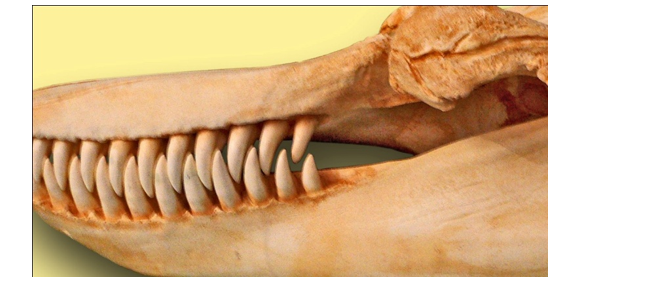
- Heterodont dentition: where an organism has teeth of different sizes and shapes that is incisors, canines, premolars and molars. Heterodont dentition is common with mammals and reptiles.
Incisors
- Are flat and chisel shaped with sharp ridged edges for cutting and biting food.
- They have one root.
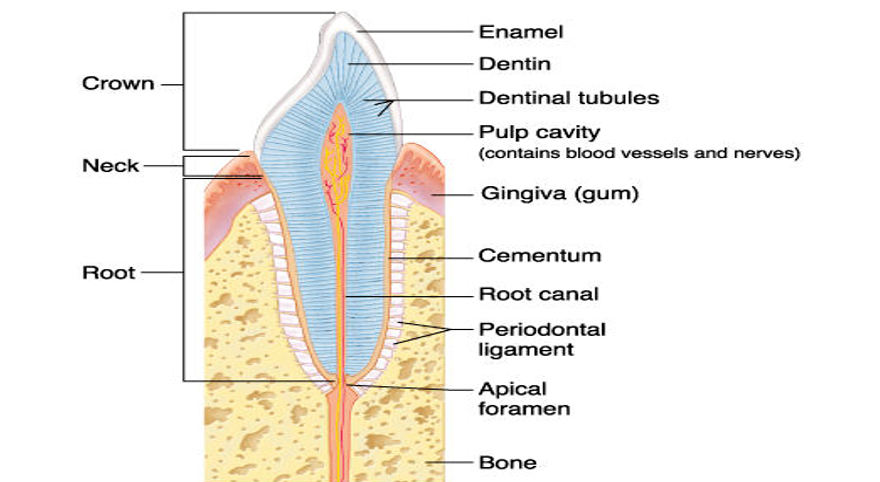
Canines
- Are conical teeth with sharp pointed edges modified for seizing and tearing prey among carnivores.
- They have one root
Premolar and molar
- They have cusps on their surface to suit their grinding action.
- Premolars have two roots.
- Molars have either two or three roots.
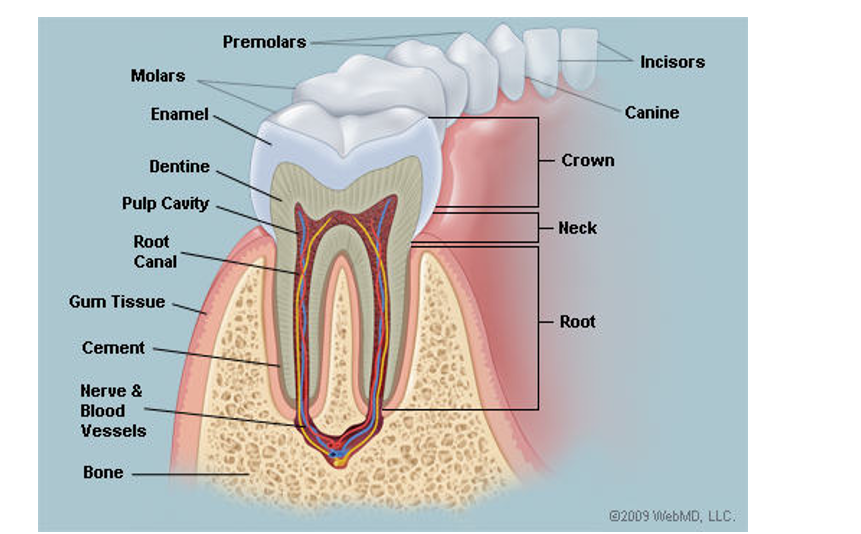
Classes of Holozoic Heterotrophs
- Holozoic heterotrophs are classified according to the type of food they consume.
- These are:
- Herbivores: heterotrophs that exclusively feed on vegetation.
- Carnivores: heterotrophs that exclusively feed on flesh.
- Omnivores: heterotrophs that feed on both flesh and vegetation.
- Dentition of heterotrophs is based on the kind of food they consume.
Dental Formula
- This is the description of the number, type and position of teeth in the jaws of animals.
- Number of teeth recorded represents half the total teeth in the upper and lower jaws.
- The teeth names are abbreviated as
- i-incisors.
- c-canines.
- pm-premolars.
- m-molars.
- An animal was found to have no incisors and canines on the upper jaw. It had six premolars and four molars on the upper jaw. On the lower jaw, it had eight incisors, no canines, six premolars and six molars.
- Write down its dental formula.
- State its mode of feeding.
- Give a reason.
Herbivores
- Most do not have upper incisors. Instead they have a horny pad against which grass is pressed and cut by the lower incisors.
- They have a long tongue that assists in the cutting and moving food.
- They have a gap in the lower jaw separating canines from premolars known as diastema which allows the tongue to manipulate food.
- Herbivore teeth have open enamel which allows for continuous growth to replace worn out surfaces due to grinding.
- Their incisors are wedge shaped to cut grass and vegetation together with the horny pad
- The jaws have movable joints to allow the sideways movement of lower jaw to facilitate grinding of grass.
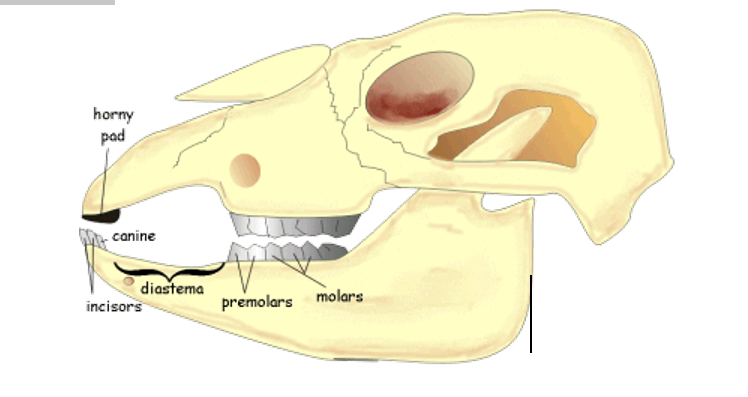
Carnivores
- Their incisors are chisel shaped and closely fitting to seize the prey.
- Their canines are long, conical and curved to hold, kill and tear the prey.
- Some of their premolars in the lower and upper jaw are modified into specialized carnassial teeth which have smooth sides and sharp edges to slice through flesh and crush bones
- Premolars and molars are broad with cusps for crushing bones.
- Their jaws are attached to powerful muscles that move the jaws up and down
- Carnivores are adapted to fast running by possessing well developed leg muscles.
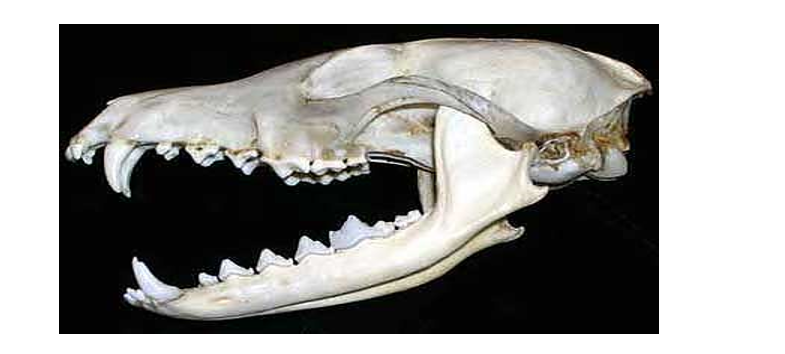
Dental Diseases
Dental Carries
- Caused by lack of hard food, too much sweet or sugary food, lack of calcium in diet, lack of vitamin D, lack of cleaning teeth and general ill-health. The bacteria in the mouth break down the sugars to form energy and organic acids. The acids corrode the enamel.
Periodontal Diseases
- Caused by lack of vitamins A and C, lack of massage of the gums and imperfect cleaning of gums.
- The gums become flabby and soft so they do not support the teeth. Common in adults than children.
- Are of two types:
- Gingivitis– Characterized by reddening of gums, bleeding and pus in the gums.
- Pyorrhea– The teeth become loose due to infection of the fibres holding the teeth in the sockets.
Dental Hygiene
- Proper teeth care requires:
- Regular cleaning or brushing teeth after every meal
- Avoid eating too much sugary foods.
- Eating hard foods e.g. raw carrots, cassava, yams, sugar cane.
- Eating diet rich in calcium, phosphate and vitamins A, C and D.
- Teeth should be used for their correct purpose.
- Regularly visit the dentist if necessary.
DIGESTION
- The process through which complex food substances is broken down physically and chemically into simpler food substances that can be absorbed by body cells.
- However, small molecules like those of vitamins, mineral salts and water are directly absorbed into the bloodstream without undergoing digestion.
- Digestion occurs in the mouth, stomach, duodenum and ileum.
- There are glands also associated to the digestive system. These include the pancreas, gall bladder, salivary glands.
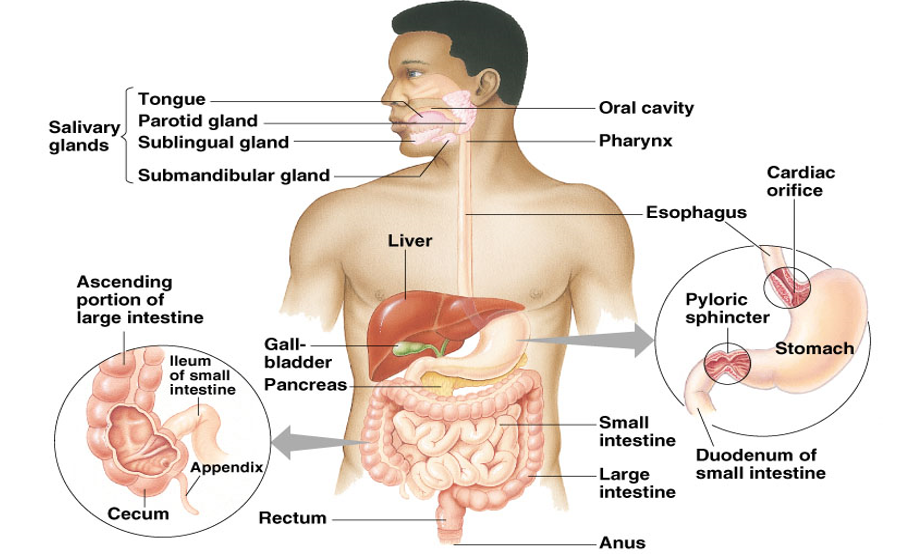
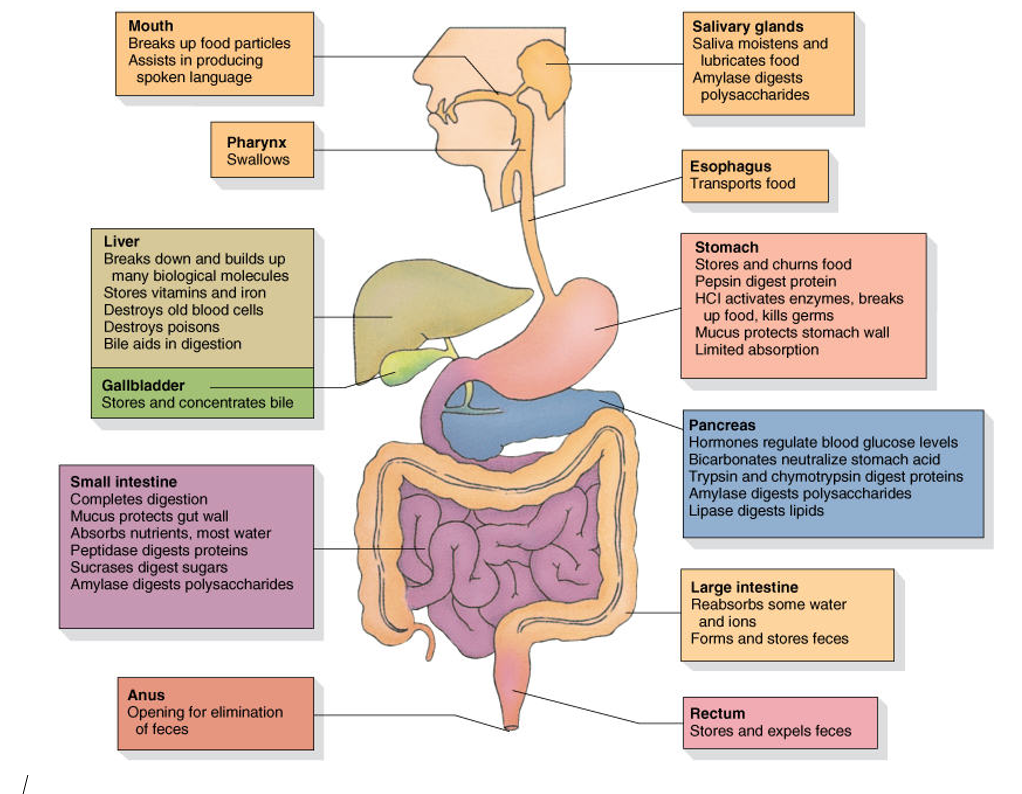
Digestion in the mouth
- At the mouth both physical and chemical digestion takes place.
- The food is mechanically broken down by the teeth through grinding and chewing. This process is called mastication.
- Mastication reduces the food into small size to increase the surface area for enzymatic action.
- The tongue helps in manipulation of the food as it mixes the food with the saliva secreted from the salivary glands. The salivary glands are:
- Sublingual salivary gland; beneath the tongue
- Sub mandibular gland: under the jaw
- Parotid gland: Found in the cheeks in front of the ears.
- All the glands have ducts through which saliva is directed to the mouth.
- The tongue also rolls the food into small round masses called boluses. The boluses are then pushed to the back of the mouth to initiate the swallowing process. The boluses are then moved to the stomach via oesophagus. Movement is facilitated by a wave of muscular contractions of longitudinal and circular muscles of the oesophagus known as peristalsis.
- There is a flap of cartilage, epiglottis which closes the wind pipe (trachea) during swallowing.
Digestion in the stomach
- Upon swallowing, the boluses move down the gullet to the stomach. The boluses enter the stomach via the cardiac sphincter (a muscular valve).
- The stomach has thick circular and longitudinal muscle layers which contract and relax to produce movements that mix the contents of the stomach. The mixing process is known as churning and results in formation of a fluid called chyme
- Arrival of food in the stomach stimulates secretion of the hormone gastrin which stimulates the gastric glands in the stomach walls to secrete gastric juice which contains:
- Pepsinogen-This is activated to pepsin which breaks down proteins to peptides.
- Rennin– Digests caseinogens protein in milk to casein (curd).
- Hydrochloric acid– This:
- Activates pepsinogen to pepsin
- Provides a favorable medium for action of the enzymes rennin and pepsin
- Kills some bacteria ingested with food.
Mucus– Forms a protective barrier to the stomach wall against corrosion by the HCl. Mucus is secreted by goblet cells in the epithelial membrane of the alimentary canal.
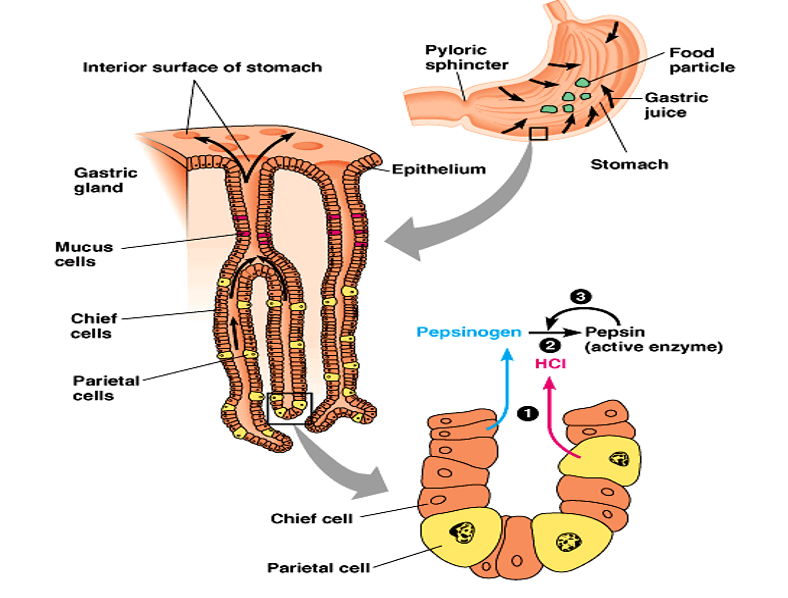
Duodenum
- The chyme then passes down to the duodenum through the pyloric sphincter. Duodenum is the first section of the small intestine. In humans it measures about 25-38 cm. the chyme is let down into the duodenum in small quantities.
- Secretions that contribute to digestion at the duodenum are received from:
- Gall bladder in the liver- Secretes bile.
- Pancreas- Secrete hormones and digestive enzymes.
- Arrival of food in the duodenum stimulates secretion of
- Secretin hormone from the pancreas: Secretin stimulates secretion of pancreatic juice into the duodenum
- Cholecystokinin from the duodenal wall: This stimulates secretion of bile from the gall bladder.
- Pancreatic juice contains:
- Pancreatic amylase– This facilitates breakdown of the remaining starch into maltose
- Trypsin– Digests proteins into peptides.
- Pancreatic juice-Digests lipids into fatty acids and glycerol
- Sodium hydrogen carbonate– This:
- Provides alkaline medium for activity of the duodenum enzymes.
- It also neutralizes the acidic chyme.
- The bile juice contains bile salts that include sodium glycocholate and sodium taurocholate. These salts:
- Aid in emulsification (breakdown of fat molecules into tiny fat droplets to increase surface area for digestion).
- The salts also provide a suitable alkaline medium for action of the duodenal enzymes.
- In addition they neutralize the acidic chyme.
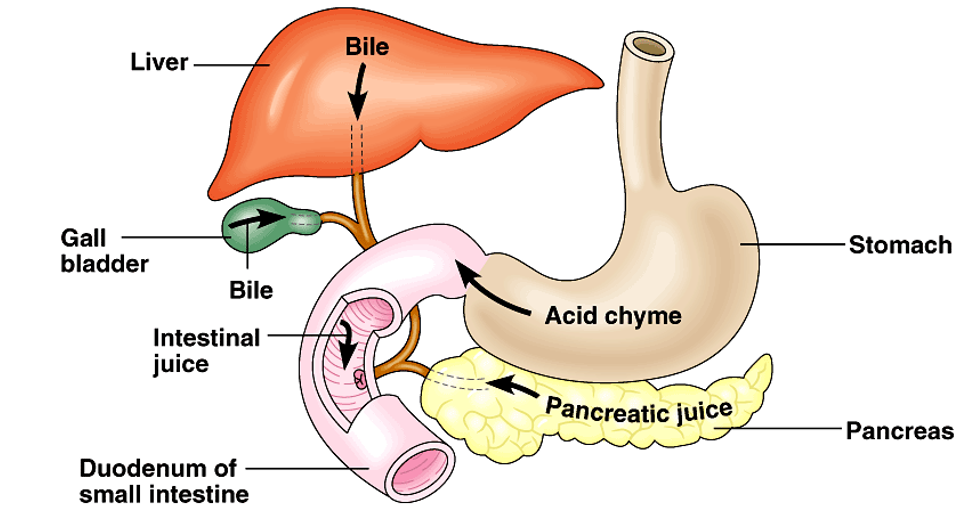
Digestion in the ileum
- Ileum is the final part of the small intestine.
- The inner cells contain secretory cells some of which secrete mucus while some secrete an alkaline fluid known as succus entericus (intestinal juice). The arrival of chyme in ileum stimulates secretion of intestinal juice which contains:
- Maltase: speeds up breakdown of maltose to glucose
- Sucrase: speeds breakdown of sucrose to glucose and fructose
- Peptidase: speeds breakdown of peptides to amino acids
- Lipase: speeds breakdown of lipids to fatty acids and glycerol.
- Lactase: speeds breakdown of lactose to glucose and galactose.
- Polypeptidase: speeds breakdown of plypeptides into amino acids
Note:
- The mucus secreted by the goblet cells lubricates food along the alimentary canal and also protect the canal from being digested by enzymes.
- At the end of digestion in the ileum, the resulting watery emulsion is called chyle; it contains soluble end products of digestion ready to be absorbed.
ABSORPTION
- This is the process through which the soluble end products of digestion diffuse into the cellular lining of the villi.
- Absorption of micronutrients such as water soluble vitamins, mineral salts and alcohol are absorbed at the stomach. Alcohol is equally absorbed here without undergoing digestion.
- Most absorption of end products of digestion occurs in the ileum.
- Molecules of amino acids and glucose pass through the epithelial lining and capillary walls into the blood system by active transport.
- The capillaries drain into the hepatic portal vein where the absorbed products are transported to the liver before they are circulated to other body parts.
- The fatty acids are absorbed into the lacteals of the villi which drain into the lymphatic vessels. The lymphatic vessels later join the blood circulatory system which transports them to other body parts.
- The ileum is adapted to absorption in many ways
- It is long to provide a large surface area for absorption
- It has a narrow lumen so as to bring the digested food into close contact with the walls of the ileum for easier absorption
- It is highly coiled to slow down movement of food thus allowing more time for digestion and absorption of food.
- The inner surfaces have numerous villi and microvilli to increase surface area for absorption of end products of digestion.
- The epithelial lining is one cell thick to reduce the distance through which digested food diffuses.
- Has a dense network of blood capillaries into which digested food materials diffuse to increase transport and thus maintain a steep concentration gradient.
- Have lacteal vessels in the villi for absorption of fatty acids and glycerol.
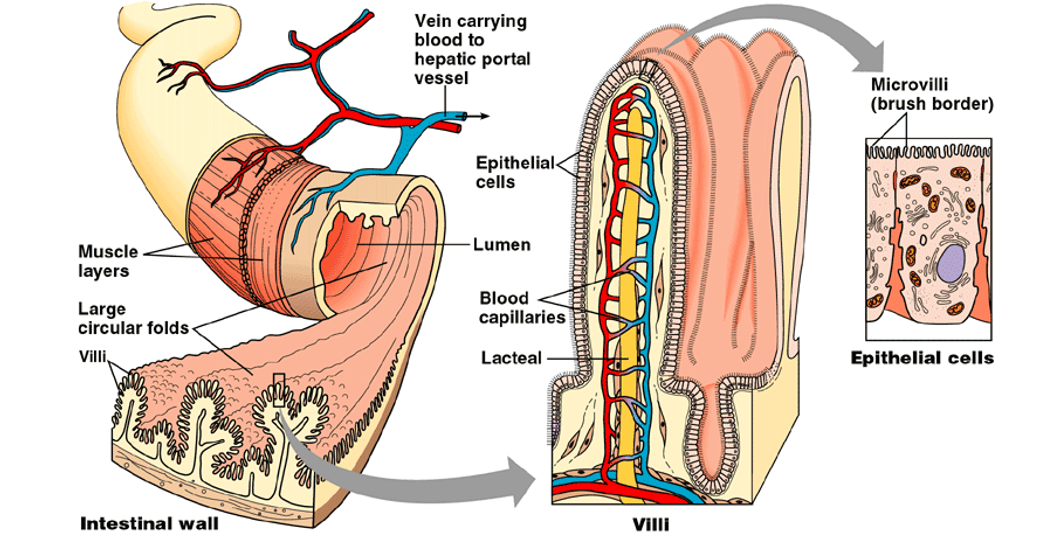
Egestion
- This is the process through which the undigested and indigestible food substances are eliminated from the body.
Caecum and Appendix
- While these have no roles in man, they play vital roles in the ruminant animals and other herbivores. They contain some bacteria which secrete cellulose enzyme. These enzymes digest cellulose since most digestive systems cannot secrete cellulose digesting enzyme. The bacteria and the herbivores are in a symbiotic relationship.
Assimilation
- This is process of incorporation of the end products of digestion into the cell metabolism. It involves utilization of the end products of digestion into various uses.
Glucose
- Oxidized to release energy
- Excess glucose is stored under the skin to provide heat insulation
- Glucose is used to synthesize complex polysaccharide such as cellulose that is an important structural compound in plants.
Fatty acids and glycerol
- Oxidized to release energy
- Combine to form neutral fats stored under the skin to provide heat insulation
- Used to build structures
Amino acids
- Used to synthesize proteins for general body growth
- Oxidized during starvation to release energy.
Vitamins
- These are organic chemical compounds that are essential for a healthy body.
- Some are synthesized in the body through the action of some microorganisms while some are also obtained in fresh fruits and vegetables.
- Vitamins are destroyed when foods are excessively cooked. They are required in small quantities.
- They play vital roles in metabolic reactions. Some act as co-enzymes while some influence the intake of certain substances. In particular, vitamin C influences uptake of iron while vitamin D influences absorption of calcium ions in the gut.
- Lack of vitamins in the body results into abnormities that manifest through various deficiency diseases. These deficiency diseases can be corrected by inclusion of the deficient vitamins in the diet or taking the vitamin supplements.
- There are two classes of vitamins owing to their solubility:
- Fat soluble vitamins– They dissolve in fats and are often stored in the liver. Include Vitamins A, D, E, K.
- Water soluble vitamins– Dissolve in water. Include vitamins B1, B2, B5, B12 and C
Mineral salts
- These are important inorganic compounds containing elements required for essential body functioning. Depending on body requirements, mineral salts are of two classes:
- Macro-nutrients: Nutrients required in large quantities. These include nitrogen, sulphur, phosphorous, calcium, sodium, iron and magnesium.
- Micro-nutrients: Nutrients required in small quantities. Include copper, manganese, boron, iodine and cobalt.
Roughages
- This is the indigestible material in food. Mainly composed of cellulose from plant cell walls.
- They are found in full cereals, fresh fruit fibres like lemons, oranges, mangoes and vegetables.
Importance of roughage
- It rubs against the walls of the alimentary canal stimulating secretion of digestive enzymes and mucus to lubricate the epithelial lining.
- Roughage enhance peristalsis since as they rub against the walls of the alimentary canal, they stimulate contraction and relaxation of the muscles.
- Roughage is an absorbent; it extracts water from the alimentary canal making the fecal matter bulky and moist hence can be easily propelled by peristaltic movements. This prevents constipation.
Factors affecting energy requirements in humans
Discuss how the following factors affect energy requirements in humans:
- Basal metabolic rate
- Occupation
- Health of an individual
- Age
- Sex
- Body size
- Environmental temperature
